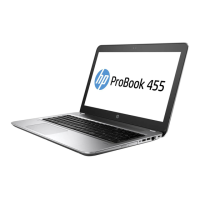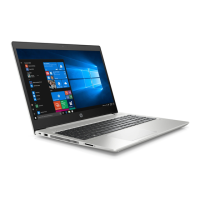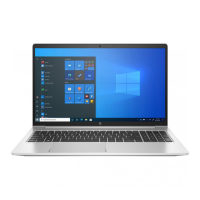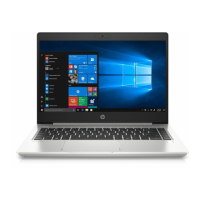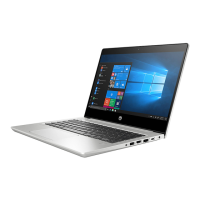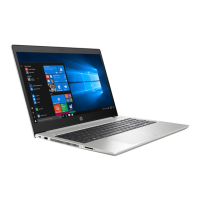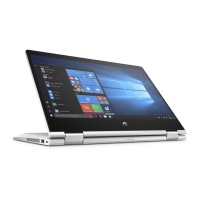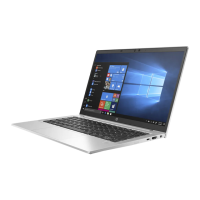Do you have a question about the HP ProBook 455 G7 and is the answer not in the manual?
Details and descriptions of components located on the right side of the computer.
Details and descriptions of components located on the left side of the computer.
Details and descriptions of components related to the computer display.
Details and descriptions of components within the keyboard area.
Description of the touchpad and its functions.
Descriptions of various indicator lights on the computer.
Details and descriptions of buttons, speakers, and the fingerprint sensor.
Information about special keys and their functions on the keyboard.
Explanation of hot key combinations for specific products.
Description of components visible on the bottom of the computer.
Information about the various labels affixed to the computer.
Catalog of major computer components with part numbers.
Catalog of display-related components with part numbers.
Catalog of cables included in the cable kit with part numbers.
Catalog of brackets included in the bracket kit with part numbers.
Catalog of mass storage devices with part numbers.
Catalog of miscellaneous computer parts with part numbers.
List of tools necessary for component removal and replacement procedures.
Important considerations for disassembly and assembly procedures.
Precautions for handling plastic parts during service.
Guidelines for safely handling cables and connectors.
Specific precautions for handling storage drives.
Guidelines for setting up a safe and effective workstation.
Information on preventing damage from electrostatic discharge.
General procedures for replacing computer components.
Steps required before starting the disassembly process.
Instructions for enabling Battery Safe mode for component service.
Procedure for removing the computer's bottom cover.
Procedure for removing the computer battery.
Procedure for removing and replacing memory modules.
Procedure for removing the WLAN/Bluetooth combo card.
Procedure for removing and replacing the M.2 solid-state drive.
Procedure for removing and replacing the hard drive.
Procedure for removing the speaker assembly.
Procedure for removing and replacing the system fan.
Procedure for removing and replacing the heat sink.
Procedure for removing and replacing the USB board.
Procedure for removing the battery connector board.
Procedure for removing and replacing the touchpad assembly.
Procedure for removing the fingerprint sensor assembly.
Procedure for removing and replacing the card reader board.
Procedure for removing the RTC battery.
Procedure for removing and replacing the system board.
Procedure for disassembling and removing the display assembly.
Procedure for removing and replacing the power connector cable.
Procedure for removing the keyboard and top cover assembly.
Guide to navigating and using the computer setup (BIOS) utility.
Instructions for updating the computer's BIOS.
How to dynamically choose a boot device using the F9 prompt.
Information on configuring Trusted Platform Module (TPM) settings.
Guide to using HP Sure Start for BIOS security and recovery.
Using the Windows-based utility for hardware diagnostics.
Instructions for downloading the HP PC Hardware Diagnostics Windows tool.
Steps to install the HP PC Hardware Diagnostics Windows tool.
Using the UEFI utility for hardware diagnostics outside the OS.
Steps to start the HP PC Hardware Diagnostics UEFI tool.
Guide to downloading the UEFI tool to a USB flash drive.
Instructions for downloading the latest UEFI diagnostic version.
Downloading the UEFI tool using product name or number.
Guide to using and customizing remote UEFI diagnostic settings.
Information on backing up data and creating recovery media.
Overview of options for restoring, resetting, and refreshing the computer.
Guide to using HP Sure Recover for OS and driver restoration.
Detailed specifications for the computer's hardware.
Specifications related to the computer's display panel.
Specifications for the computer's hard drive options.
Specifications for the computer's solid-state drive options.
Steps related to BIOS operations and memory handling.
Information about nonvolatile memory types and usage.
Frequently asked questions and answers about BIOS and memory.
General requirements for power cord sets applicable to all regions.
Region-specific requirements for power cord sets.
Details and descriptions of components located on the right side of the computer.
Details and descriptions of components located on the left side of the computer.
Details and descriptions of components related to the computer display.
Details and descriptions of components within the keyboard area.
Description of the touchpad and its functions.
Descriptions of various indicator lights on the computer.
Details and descriptions of buttons, speakers, and the fingerprint sensor.
Information about special keys and their functions on the keyboard.
Explanation of hot key combinations for specific products.
Description of components visible on the bottom of the computer.
Information about the various labels affixed to the computer.
Catalog of major computer components with part numbers.
Catalog of display-related components with part numbers.
Catalog of cables included in the cable kit with part numbers.
Catalog of brackets included in the bracket kit with part numbers.
Catalog of mass storage devices with part numbers.
Catalog of miscellaneous computer parts with part numbers.
List of tools necessary for component removal and replacement procedures.
Important considerations for disassembly and assembly procedures.
Precautions for handling plastic parts during service.
Guidelines for safely handling cables and connectors.
Specific precautions for handling storage drives.
Guidelines for setting up a safe and effective workstation.
Information on preventing damage from electrostatic discharge.
General procedures for replacing computer components.
Steps required before starting the disassembly process.
Instructions for enabling Battery Safe mode for component service.
Procedure for removing the computer's bottom cover.
Procedure for removing the computer battery.
Procedure for removing and replacing memory modules.
Procedure for removing the WLAN/Bluetooth combo card.
Procedure for removing and replacing the M.2 solid-state drive.
Procedure for removing and replacing the hard drive.
Procedure for removing the speaker assembly.
Procedure for removing and replacing the system fan.
Procedure for removing and replacing the heat sink.
Procedure for removing and replacing the USB board.
Procedure for removing the battery connector board.
Procedure for removing and replacing the touchpad assembly.
Procedure for removing the fingerprint sensor assembly.
Procedure for removing and replacing the card reader board.
Procedure for removing the RTC battery.
Procedure for removing and replacing the system board.
Procedure for disassembling and removing the display assembly.
Procedure for removing and replacing the power connector cable.
Procedure for removing the keyboard and top cover assembly.
Guide to navigating and using the computer setup (BIOS) utility.
Instructions for updating the computer's BIOS.
How to dynamically choose a boot device using the F9 prompt.
Information on configuring Trusted Platform Module (TPM) settings.
Guide to using HP Sure Start for BIOS security and recovery.
Using the Windows-based utility for hardware diagnostics.
Instructions for downloading the HP PC Hardware Diagnostics Windows tool.
Steps to install the HP PC Hardware Diagnostics Windows tool.
Using the UEFI utility for hardware diagnostics outside the OS.
Steps to start the HP PC Hardware Diagnostics UEFI tool.
Guide to downloading the UEFI tool to a USB flash drive.
Instructions for downloading the latest UEFI diagnostic version.
Downloading the UEFI tool using product name or number.
Guide to using and customizing remote UEFI diagnostic settings.
Information on backing up data and creating recovery media.
Overview of options for restoring, resetting, and refreshing the computer.
Guide to using HP Sure Recover for OS and driver restoration.
Detailed specifications for the computer's hardware.
Specifications related to the computer's display panel.
Specifications for the computer's hard drive options.
Specifications for the computer's solid-state drive options.
Steps related to BIOS operations and memory handling.
Information about nonvolatile memory types and usage.
Frequently asked questions and answers about BIOS and memory.
General requirements for power cord sets applicable to all regions.
Region-specific requirements for power cord sets.
| Graphics | AMD Radeon Graphics |
|---|---|
| Operating System | Windows 10 Pro |
| Processor | AMD Ryzen 3/5/7 |
| Display | 15.6-inch, 1920 x 1080 pixels |
| RAM | Up to 32GB DDR4 |
| Storage | Up to 1TB SSD |
| Battery | 3-cell, 45 Wh Li-ion |
| Ports | HDMI, headphone/microphone combo |
| Wireless | Bluetooth 5.0 |

